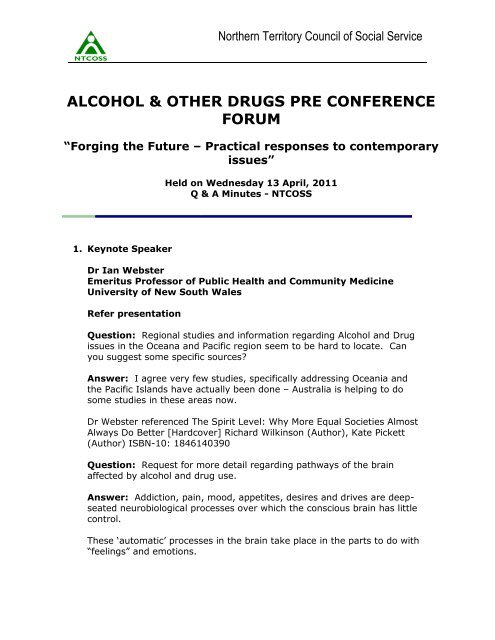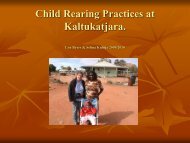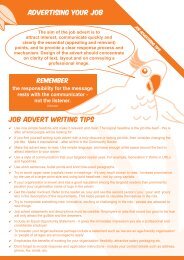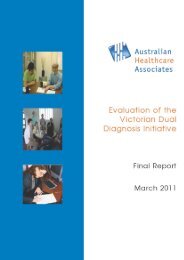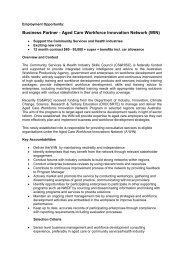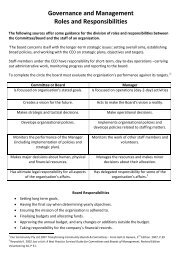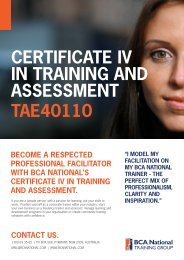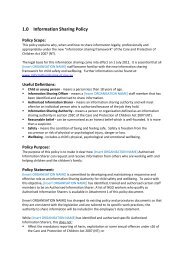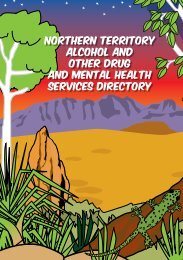AOD Pre Conference Question and Answer Minutes - Northern ...
AOD Pre Conference Question and Answer Minutes - Northern ...
AOD Pre Conference Question and Answer Minutes - Northern ...
- No tags were found...
You also want an ePaper? Increase the reach of your titles
YUMPU automatically turns print PDFs into web optimized ePapers that Google loves.
<strong>Northern</strong> Territory Council of Social ServiceALCOHOL & OTHER DRUGS PRE CONFERENCEFORUM“Forging the Future – Practical responses to contemporaryissues”Held on Wednesday 13 April, 2011Q & A <strong>Minutes</strong> - NTCOSS1. Keynote SpeakerDr Ian WebsterEmeritus Professor of Public Health <strong>and</strong> Community MedicineUniversity of New South WalesRefer presentation<strong>Question</strong>: Regional studies <strong>and</strong> information regarding Alcohol <strong>and</strong> Drugissues in the Oceana <strong>and</strong> Pacific region seem to be hard to locate. Canyou suggest some specific sources?<strong>Answer</strong>: I agree very few studies, specifically addressing Oceania <strong>and</strong>the Pacific Isl<strong>and</strong>s have actually been done – Australia is helping to dosome studies in these areas now.Dr Webster referenced The Spirit Level: Why More Equal Societies AlmostAlways Do Better [Hardcover] Richard Wilkinson (Author), Kate Pickett(Author) ISBN-10: 1846140390<strong>Question</strong>: Request for more detail regarding pathways of the brainaffected by alcohol <strong>and</strong> drug use.<strong>Answer</strong>: Addiction, pain, mood, appetites, desires <strong>and</strong> drives are deepseatedneurobiological processes over which the conscious brain has littlecontrol.These „automatic‟ processes in the brain take place in the parts to do with“feelings” <strong>and</strong> emotions.
Whether we feel well <strong>and</strong> good about ourselves, or unwell, depends onthese deep-seated processes.It is not surprising that in a beautiful network when one system faltersothers will falter as well.<strong>Question</strong>: The recent commonwealth Alcohol Treatment Guidelines madeno mention of Detox/Sobering Up Shelters – how can we fix this lack offocus?<strong>Answer</strong>: Yes, it is extraordinary if this is the case – the communitysector in the NT must continue to beat the drum <strong>and</strong> argue for an <strong>AOD</strong>Peak in the NT.<strong>Question</strong>: In light of this Alcohol Treatment Guidelines issue, wouldn‟t an<strong>AOD</strong> Peak in the NT be a necessity?<strong>Answer</strong>: Yes, Drug <strong>and</strong> Alcohol treatment is a low priority in health – theNGO‟s must continue to argue for the cause through the peaks.<strong>Question</strong>: We agree that <strong>AOD</strong> occupies the lowest level of attention inHealth –why is this?<strong>Answer</strong>: Ref: The Road Home Report – no exist in homelessnessNo synergy between health services <strong>and</strong> social services like housing,corrections, parole boards <strong>and</strong> mental health. All the systems sees with aperson leaving prison is a different person – not a person with a drugdependency or cognitive disability.<strong>Question</strong>: Do you consider there is a problem with people with MentalHealth issues also being labeled as having a Drug <strong>and</strong> Alcohol problem?<strong>Answer</strong>: To some extent there is a problem with how we label people – Ican certainly say that I have observed that young people prefer to beidentified as having mental health issues.2. Keynote SpeakerDr Tricia NagelHead, Healing <strong>and</strong> Resilience DivisionAustralian Integrated Mental Health Initiative (AIMhi)Menzies School of Research HealthRefer presentationPage 2
<strong>Question</strong>: Are AIMhi resources developed for use of indigenous peopleonly? Can they be developed for wider use? Can anyone use the AIMhiassessment form tool?<strong>Answer</strong>: AIMhi develops a range of tools – they are generally imagery<strong>and</strong> language client-centred – the pictorial tools can be taken <strong>and</strong>embedded into other systems. We welcome this, examples of thisintregration work a Perinatal Group in Kunnanurra did this <strong>and</strong> called it“Me <strong>and</strong> My Baby” <strong>and</strong> also the recent work done by Congress inadapting AIMhi material.There are a number of projects going on which are interweaving AIMhitools into other treatment systems - we encourage this adaptation.<strong>Question</strong>: Are you aware of differences in health in remote outstations<strong>and</strong> larger remote communities?<strong>Answer</strong>: Yes there are differences – one recently studied <strong>and</strong>documented was in gambling addiction – it appears the outstations hada closer link to family <strong>and</strong> traditional lifestyle – which may prove apositive influence.<strong>Question</strong>: Can you comment on the evidence that counseling is usedless in the NT?<strong>Answer</strong>: I can say that there is a lack of client focus in the NT, so thereis less evidence of the use or success of counseling.Note: Dr Nagel‟s time was limited <strong>and</strong> she recognized there were still anumber of questions coming from the audience. She extended aninvitation to attendees to work with Menzies School of Research Healthto answer these questions.3. Guest SpeakersMatthew BonsonChief Executive Officer&Patrick StephensonTraining ManagerCouncil for Aboriginal Alcohol Program Services Inc (CAAPS)Page 3
Refer presentationAlthough there was no time for questions following this presentation, DrIan Webster (Chair) made the following comments:- Understood the concern of organizations such as CAAPS havingcomplex, high risk clients transferred to NGOs via governmentinstruments.- Underst<strong>and</strong>s that this means that the risks of community <strong>and</strong>society are being transferred to organizations such as CAAPS.- A more holistic approach should be considered.- Volatile Substance Abuse Program is underfunded – this againposes a real risk to society <strong>and</strong> organizations such as CAAPS4. Guest SpeakerAndrew BivenCo-morbidity CoordinatorSA Network of Drug <strong>and</strong> Alcohol Services (SANDAS)E-Learning Module – <strong>Pre</strong>scription MH medication <strong>and</strong> Alcohol <strong>and</strong>other DrugsRefer presentationAndrew presented functionality of the E-learning module – he advisedthat this was not a clinical tool <strong>and</strong> its target audience was not medicalclinicians rather it was designed to offer a blended learning approach.The development of the tool was funded though an AER WorkforceDevelopment Grant <strong>and</strong> developed by E 3 Learning – costings arepresently $22.00 per employee <strong>and</strong> this provides a 12 monthsubscription <strong>and</strong> access to the training.Additional information can be found athttp://s<strong>and</strong>asonlinelearning.e3learning.com.auPage 4
5. Guest SpeakerMicheil BrodieExecutive Director, Licensing, Regulation <strong>and</strong> Alcohol Strategy<strong>Northern</strong> Territory Department of Justice“Enough is Enough Campaign”Refer presentation – 1 slide<strong>Question</strong>: Can you please clarify „voluntary referral‟ is this from a clientor an organization?<strong>Answer</strong>: Voluntary referral is by an organisation – it should be notedthat there is no obligation on an organisation to make a referral to theTribunal <strong>and</strong> further discussion needs to happen around this insideorganisations.<strong>Question</strong>: How does this plan go to capturing problems drinkers onMitchell Street?<strong>Answer</strong>: This scheme is not directed at Mitchell St issues - theGovernment made some changes to the Liquor Act last year that assistin that domain. But it is also not right to characterise these reforms asbeing targeted at aboriginal populations. It‟s worth noting that many ofthe pathways to banning are dominated by non-aboriginal residents.<strong>Question</strong>: Can you please clarify operational functionality <strong>and</strong>jurisdiction of these new measures?<strong>Answer</strong>: Simply, there is a structural separation between non-criminalmatters which go to the Tribunal eventually <strong>and</strong> criminal matters that goto the Smart Court.<strong>Question</strong>: Is there a policy barrier to a volumetric tax on the sale ofalcohol in the NT?<strong>Answer</strong>: Minister Lawrie is on the record as a supporter of a volumetrictax on alcohol. There was great success with the „Living with Alcohol‟Program.<strong>Question</strong>: Has any consultation gone on with other states regarding theimpact of these new measures across State borders for example, SouthAustralia?Page 5
<strong>Answer</strong>: Yes, we have spoken to other states – there does not seem tobe much sympathy for the argument about the impact on the otherstates. We underst<strong>and</strong> that people in Central Australia don‟t pay muchattention to the arbitrary borders <strong>and</strong> boundaries – these people move alot anyway.The reality for the NT is that we have to start making substantialchanges.<strong>Question</strong>: What assurances around confidentiality of the informationbeing collected <strong>and</strong> checked at the Point of Sale can you provide?<strong>Answer</strong>: No whole piece of individual data is held in an unsecure place.All the BDR information is held at a central server. An OCR (OpticalCharacter Reader) at the sale premises creates a unique identifierrather than specific individual data.Also the system does not capture information that is accessible by thelicensee.<strong>Question</strong>: Has any thought been given to security at the take awayalcohol premises if the licensee refuses to sell alcohol to a banneddrinker?<strong>Answer</strong>: We are working through this with the industry at this time.There is going to be a training package developed that will provideinformation on the following:- How to work the new equipment- How to h<strong>and</strong>le escalating conflict – strategies for staff <strong>and</strong>licensees- Additional relevant collateral<strong>Question</strong>: Is the Banned Drinkers Register going to be a publicdocument?<strong>Answer</strong>: No<strong>Question</strong>: If someone presents with no ID <strong>and</strong> tries to buy alcohol,what will happen?<strong>Answer</strong>: They will not be allowed to purchase any alcohol.<strong>Question</strong>: Come July, with the implementation of these new measures,has there been any thought given to the transfer of pressure onto:Page 6
- Family members <strong>and</strong> partners in the form of threats <strong>and</strong> violenceto purchase alcohol on behalf of banned drinkers?- Alternative drugs?- Withdrawal <strong>and</strong> Detox services?<strong>Answer</strong>: The government will assist by investing additional funding intoa range of <strong>AOD</strong> services across the Territory – I cannot advise whatthese services will be at this time. Also the Department of Health isworking to set up support structures that will funnel people into anassessment process.Finally we are only expecting a small swing to substances substitution,at this time.<strong>Question</strong>: Can you clarify how secondary supply of alcohol will beh<strong>and</strong>led?<strong>Answer</strong>: Secondary supply is not illegal but suppliers can get bannedas well. Also irresponsible supply to a minor is now an offence.<strong>Question</strong>: Can you please advise about the length of bans <strong>and</strong> does itonly apply to take away premises?<strong>Answer</strong>: 1 st Ban - 3 months2 nd Ban - 6 months3 rd Ban - 2 years4 th Ban – longerBans can be lifted when acceptable proof of stabilization is provided –the tribunal will need to review consumption history to rule on thesematters. The bans are on the possession consumption <strong>and</strong> purchase ofalcohol – not just the purchase of takeaway alcohol.<strong>Question</strong>: How many problem drinkers will need to be banned beforethe NT comes down to the national average of alcohol consumption?<strong>Answer</strong>: We don‟t have information on individual consumption rates.We are expecting 2,000 to 3,000 people will be banned in the first 12months of the introduction of this system.It may be of interest to know that in the NT 10% of the populationconsumes 50% of the alcohol (Based on WHO estimates ofconsumption).Page 7
<strong>Question</strong>: Is something similar planned to for licensed premises, in thefuture?<strong>Answer</strong>: Not at yet – this is not a “silver bullet”- it is a set of measures.<strong>Question</strong>: What happens to people after the assessment process?What strategies <strong>and</strong> resources will be made available <strong>and</strong> when?<strong>Answer</strong>: The government is already talking to Service Providers tobuild capacity in the system. The Minister will also make relevantannouncements sometime between now <strong>and</strong> the budget in mid-May.6. Guest SpeakersA very brave <strong>and</strong> forthright consumer – S<strong>and</strong>iCaseworker – Am<strong>and</strong>aNurse – GinaCaseworker from MHACA – ChristineRepresentative from the patient congress – WilliamRefer video presentation for S<strong>and</strong>i’s story.<strong>Question</strong>: If you are getting Mental Health assistance are you alsogetting <strong>AOD</strong> help?<strong>Answer</strong>: Yes some…but not enough <strong>and</strong> not necessarily at the righttimes.Page 8


